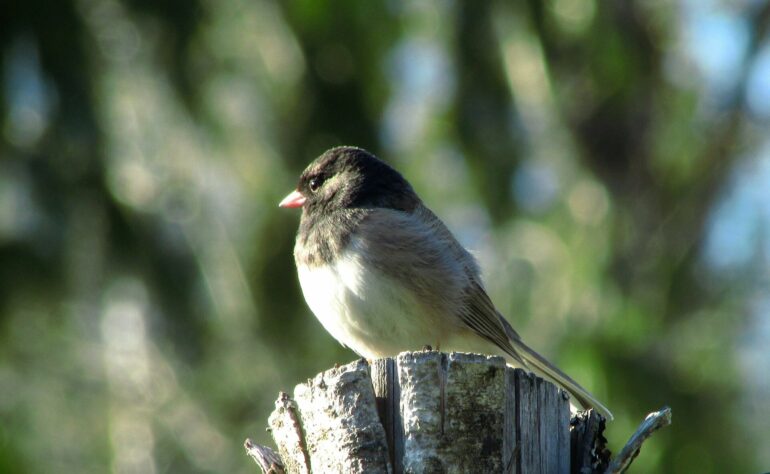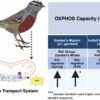When UCLA shifted to remote instruction during the early days of COVID-19, the campus was much less populated—but it wasn’t totally empty. Several species of animals continued to go about their daily lives, just with far fewer disturbances from humans.
Among them were around 300 dark-eyed juncos, a bird species that has thrived at UCLA for probably around 20 years.
A group of UCLA scientists who have been studying fear and aggression in urban juncos for years recognized that the dramatic shift in human activity presented a unique opportunity for an experiment: How would juncos adapt once campus life returned to normal?
Led by Eleanor Diamant, who was then a UCLA doctoral student, the researchers decided to find out. Specifically, they wondered, given the yearlong break from any human interaction, would juncos act more fearful once they encountered large groups of people again?
Their findings completely defied their expectations.
In a study published in Proceedings of the Royal Society B, the scientists report that once campus life returned to normal, the birds acted “drastically less fearful” of humans. The researchers had speculated before the experiment that once juncos had lost their familiarity with people, they would adopt behaviors more like their wilder cousins—who don’t typically let people get closer than about 11 1/2 feet before flying away. But that was decidedly not the case.
To judge birds’ fear levels, the scientists measured how close a person could get to the birds before they flew away. The researchers conducted the tests throughout the campus closure and again in 2022, after the campus had fully reopened. They also compared their findings with data that UCLA scientists had collected prior to the pandemic, in 2018 and 2019.
Before the closure, juncos allowed researchers to get within about 65 inches, on average, before they flew away. That figure remained consistent for the duration of the closure. But in 2022, when campus life had mostly returned to normal, juncos allowed people to get even closer—an average of just 39 inches—before they fled. The study also found that during the period of time when people were mostly absent, the birds demonstrated little change in how close they allowed humans to get.
Interestingly, there was no statistically significant difference in the behaviors of birds that hatched during the closure and those who had interacted with people before the pandemic began. (Researchers identified the juncos with individualized bands around their legs, a standard practice for studying birds.)
Juncos provided a particularly interesting case study because they feed and nest mostly on the ground, where close encounters with humans are common. Before the pandemic, UCLA’s juncos had become accustomed to the commotion of a large urban university; prior research showed that the juncos living in urban regions of Southern California were significantly less fearful of people than juncos in non-urban areas.
Biologists have two main theories about how wild birds get used to living around people in densely populated environments. The first holds that birds that encounter large numbers of humans become less fearful over time, a process called habituation. That theory also suggests that birds that live without much human interaction either will become more fearful of people or that their fear response will not change over time.
The other theory holds that birds living in cities are there in part because they innately have less fear of humans in the first place.
But Diamant said the study’s findings didn’t line up with either of those theories.
“What we found doesn’t match either of them,” she said. “If less fearful birds had chosen to live on campus in the first place, we would have expected their fear response to be essentially unchanged. If they were habituated, we would have thought they’d become more fearful during the closure and then less fearful after, or not shift their behavior at all. But these birds didn’t shift fear response with humans absent, and they shifted toward much less fearful after humans came back.”
To collect the data, researchers received permission from UCLA administrators to venture onto campus in 2020 and 2021, during the COVID-19 closure.
Pamela Yeh, a UCLA professor of ecology and evolutionary biology, and the study’s senior author, said the findings could be explained in one of two ways. First, she said, it may be that once animals’ fear response gets tamped down, new events will tamp it down further. Or it could be that the fear response, after being lowered, tends to return to its normal level, Yeh said.
Further study of UCLA’s junco population should help determine which option explains the findings.
“The effects of humans on wild animals are really complex and what we expect isn’t always what we get,” Yeh said. “So our research shows both the complexity of the juncos’ response to humans and of their response to other changes.”
The study also may offer a glimmer of hope for North American birds, whose population has diminished dramatically—due in large part to human disturbances in their natural habitats. By some estimates, there are nearly 3 billion fewer adult birds in North America alone than there were in 1970, including about 175 million fewer dark-eyed juncos.
“For me, the takeaway is that there’s so much complex animal behavior that we don’t know about, even though they are our neighbors in cities,” said Diamant, who is now a postdoctoral scholar at Ben Gurion University of the Negev in Israel. “There are these surprising reactions animals have to collective human behavior. We might not know what they are because we can’t test for them, but only these kinds of massive and unexpected events like the pandemic bring them into focus.”
More information:
Proceedings of the Royal Society B (2023). DOI: 10.1098/rspb.2023.1338. royalsocietypublishing.org/doi … .1098/rspb.2023.1338
Provided by
University of California, Los Angeles
Citation:
Birds living on a university campus found to be less afraid of humans after the pandemic closure (2023, August 22)



